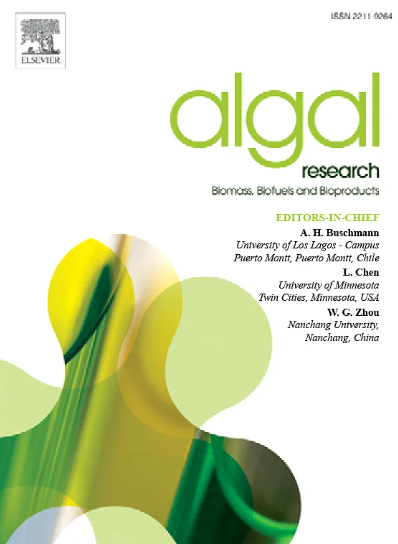利用高通量脉冲光数据的放大信息来预测光生物反应器中微藻的生长动态
IF 4.6
2区 生物学
Q1 BIOTECHNOLOGY & APPLIED MICROBIOLOGY
Algal Research-Biomass Biofuels and Bioproducts
Pub Date : 2025-04-30
DOI:10.1016/j.algal.2025.104073
引用次数: 0
摘要
单细胞绿藻(微藻)已经进化到通过光合作用利用巨大的太阳能资源来生产生物质,这是包括食品、饲料、燃料、生物材料和精细化学品在内的广泛产品的原料。因此,微藻是一系列太阳能生物技术的基础。在这项研究中,我们重新制定了一个光合单位模型,以捕捉在放大系统中由自遮光和混合引起的光暗循环的影响。我们使用脉冲和连续光照条件下莱茵衣藻的高通量筛选(HTS)数据校准和验证了我们的模型。通过重建单个细胞在培养系统中迁移的光历史,我们建立了HTS数据与扩展系统之间的联系,并使用已发表的培养数据验证了该方法。在室外微藻培养场景的案例研究中,我们展示了我们的模型如何捕获沿模拟混合周期入射太阳辐照度和衰减光强度的动态。内部模型变量的分析提供了对24小时生物量增长剖面和生物量生产力的深入了解。最后,我们展示了如何利用该模型来优化栽培系统,从而能够定义最佳预测照明强度、混合周期、接种密度和光路。这项工作代表了将小规模高温超导平台与大规模培养系统(即光生物反应器)连接起来的第一步。这为加速微藻生产系统向工业化藻类养殖和加工的规模扩大和降低风险提供了基础。本文章由计算机程序翻译,如有差异,请以英文原文为准。
Scaling-up information from high-throughput pulsed light data to predict microalgae growth dynamics in photobioreactors
Single cell green algae (microalgae) have evolved to tap into the vast solar energy resource via photosynthesis to produce biomass, which is a feedstock for a broad array of products including foods, feeds, fuels, biomaterials and fine chemicals. Microalgae are therefore the chassis for an array of solar biotechnologies.
In this study, we reformulated a photosynthetic unit model to capture the effect of light-dark cycles induced by self-shading and mixing in scaled-up systems. We calibrated and validated our model using High-Throughput Screening (HTS) data for Chlamydomonas reinhardtii under pulsed and continuous light regimes. By reconstructing the light history of individual cells migrating through a cultivation system, we established a link between HTS data and scaled-up systems, and validated the approach using published cultivation data.
In a case study of an outdoor microalgae cultivation scenario we demonstrated how our model captures the dynamics of both incident solar irradiance and attenuated light intensity along a simulated mixing cycle. The analysis of internal model variables provided insights into the 24-hour biomass growth profile and biomass productivity of the system. Finally, we showed how the model can be exploited for the optimisation of cultivation systems, enabling the definition of optimal forecast illumination intensities, mixing cycles, inoculation densities, and light paths.
This work represents a first step in linking small-scale HTS platforms with large-scale cultivation systems (i.e. photobioreactors). This provides a foundation to accelerate and de-risk the scale-up of microalgae production systems towards industrialised algae farming and processing.
求助全文
通过发布文献求助,成功后即可免费获取论文全文。
去求助
来源期刊

Algal Research-Biomass Biofuels and Bioproducts
BIOTECHNOLOGY & APPLIED MICROBIOLOGY-
CiteScore
9.40
自引率
7.80%
发文量
332
期刊介绍:
Algal Research is an international phycology journal covering all areas of emerging technologies in algae biology, biomass production, cultivation, harvesting, extraction, bioproducts, biorefinery, engineering, and econometrics. Algae is defined to include cyanobacteria, microalgae, and protists and symbionts of interest in biotechnology. The journal publishes original research and reviews for the following scope: algal biology, including but not exclusive to: phylogeny, biodiversity, molecular traits, metabolic regulation, and genetic engineering, algal cultivation, e.g. phototrophic systems, heterotrophic systems, and mixotrophic systems, algal harvesting and extraction systems, biotechnology to convert algal biomass and components into biofuels and bioproducts, e.g., nutraceuticals, pharmaceuticals, animal feed, plastics, etc. algal products and their economic assessment
 求助内容:
求助内容: 应助结果提醒方式:
应助结果提醒方式:


